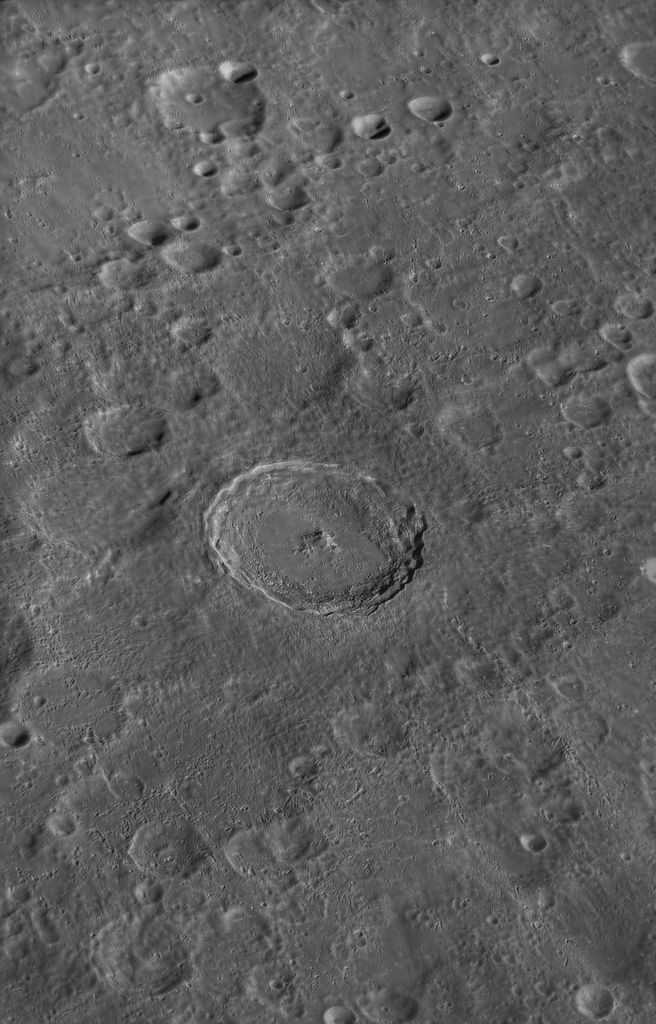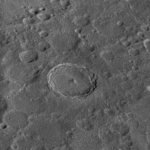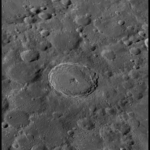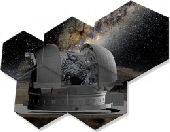Hard elab.
************************************
Soft elab.
Italiano:
Il cratere lunare “Tycho”, è localizzato nella parte meridionale della faccia visibile della Luna, e può essere osservato già ad occhio nudo (meglio con un semplice binocolo) come un piccolo puntino più luminoso, visibile a partire dal primo quarto lunare in poi. Esso è infatti uno dei crateri più luminosi della Luna, con un diametro di circa 85 km (53 mi) e una profondità di 4.800 m (15.700 piedi).
La superficie intorno a Tycho è piena di crateri di varie dimensioni, con molti crateri ancora più antichi ricoperti dal materiale ejettato dell’impatto che lo ha generato. Alcuni dei crateri più piccoli sono crateri secondari formati da grossi pezzi di “ejecta” di Tycho.
Tycho è definito in modo netto e ben delineato, a differenza degli adiacenti crateri più vecchi che sono stati degradati da impatti successivi. L’interno ha un alta albedo che è prominente quando il Sole è alto, e il cratere è circondato da un sistema di raggi ben distintivo che forma lunghe raggiere che raggiungono fino a 1.500 chilometri di lunghezza. A causa dei suoi raggi prominenti, Tycho è mappato come parte del Sistema Copernicano e sezioni di questi raggi possono addirittura essere osservate anche quando Tycho è illuminato solo dalla luce della terra (la cosidetta “luce Cinerea”).
I bastioni oltre il bordo di Tycho hanno un’albedo inferiore rispetto all’interno per una ampiezza di oltre cento chilometri e sono privi dei segni dei raggi che, invece, si possono osservare oltre. Questa albedo inferiore più scura, potrebbe essere stata formata dai minerali scavati ed espulsi durante l’impatto.
La sua parete interna è terrazzata, inclinata verso il basso su un fondo ruvido ma quasi piatto che mostra piccole colline serrate. Il fondo mostra segni di vulcanismo passato, molto probabilmente dovuto allo scioglimento delle rocce causato dall’impatto. Le cime centrali si innalzano a 1.600 metri (5.200 piedi) dal suolo e una vetta minore si trova appena a nord-est del massiccio primario.
Tycho è un cratere relativamente giovane, con un’età stimata di 108 milioni di anni, basata sull’analisi dei campioni del cratere recuperati durante la missione Apollo 17.
Inizialmente si pensava che Tycho potesse essere stato formato dall’impatto di un asteroide appartenente alla famiglia di 298-Baptistina ma, tuttavia, questa possibilità è stata esclusa, nel 2011, dal Wide-field Infrared Survey Explorer, poiché è stato scoperto che la famiglia di 298-Baptistina è stata prodotta molto più tardi di quanto fosse prima considerato formandosi, “soltanto”, circa 80 milioni di anni fa.
Infine, una particolarità di Tycho: da studi effettuati durante le osservazioni a infrarossi della superficie lunare durante un’eclissi, si è scoperto che il cratere Tycho si raffredda a una velocità inferiore rispetto ad altre parti della superficie, rendendolo un “punto più caldo” della superficie lunare. Questo effetto è causato dalla differenza dei materiali che ricoprono il cratere, originato dall’impatto.
Sono Visibili, nell’immagine, anche i crateri “Magynus” (parzialmente), “Street”, “Sasserides”, “Ball” e “Pictet”.
Grazie per la vostra cortese attenzione!
Dettagli tecnici:
Telescopio Astrofaktoria DK20 @ ~ F/19 – Baader FFC Multiplier – Baader IR 685nm filter – GS3-U323S6M-C camera – Seeing 6,5/10 in IR band – sito: Palermo @ my personal Observatory.
English:
The lunar crater “Tycho”, is located in the southern part of the visible face of the Moon, and can already be observed with the naked eye (better with a simple binocular) as a small brighter dot, visible from the first lunar quarter onwards.
It is infact one of the brightest craters on the Moon, with a diameter of approximately 85 km (53 mi) and a depth of 4,800 m (15,700 feet).
The surface around Tycho is full of craters of various sizes, with many even older craters covered with the ejected material of the impact that generated it.
Some of the smaller craters are secondary craters made up of large pieces of Tycho’s “ejecta”.
Tycho is clearly defined and well defined, unlike the adjacent older craters which have been degraded by subsequent impacts. The interior has a high albedo which is prominent when the Sun is high, and the crater is surrounded by a distinctive system of rays which forms long rays that reach up to 1,500 kilometers in length. Due to its prominent rays, Tycho is mapped as part of the Copernican System and sections of these rays can even be observed even when Tycho is illuminated only by the light of the earth (the so-called “Cinerea light”).
The ramparts beyond the edge of Tycho have a lower albedo than the inside for an amplitude of over a hundred kilometers and are devoid of the signs of the rays that, however, can be observed beyond. This darker lower albedo may have been formed from the minerals excavated and expelled during the impact.
Its internal wall is terraced, inclined downwards on a rough but almost flat bottom showing small tight hills. The bottom shows signs of past volcanism, most likely due to the melting of the rocks caused by the impact. The central peaks rise 1,600 meters (5,200 feet) above the ground and a smaller peak is located just north-east of the primary massif.
Tycho is a relatively young crater, with an estimated age of 108 million years, based on the analysis of crater samples recovered during the Apollo 17 mission.
Initially it was thought that Tycho may have been formed by the impact of an asteroid belonging to the 298-Baptistina family but, however, this possibility was excluded, in 2011, by the Wide-field Infrared Survey Explorer, since it was discovered that the family of 298-Baptistina was produced much later than it was previously thought to have formed, “only”, about 80 million years ago.
Finally, a peculiarity of Tycho: from studies carried out during infrared observations of the lunar surface during an eclipse, it was discovered that the Tycho crater cools at a lower speed than other parts of the surface, making it a “hottest point” of the lunar surface. This effect is caused by the difference in the materials that cover the crater, originating from the impact.
The craters “Magynus” (partially), “Street”, “Sasserides”, “Ball” and “Pictet” are also visible in the image.
Thanks for your kind attention!
Technical details:
Astrofaktoria DK20 telescope @ ~ F / 19 – Baader FFC Multiplier – Baader IR 685nm filter – GS3-U323S6M-C camera – Seeing 6.5 / 10 in IR band – site: Palermo @ my personal Observatory.



